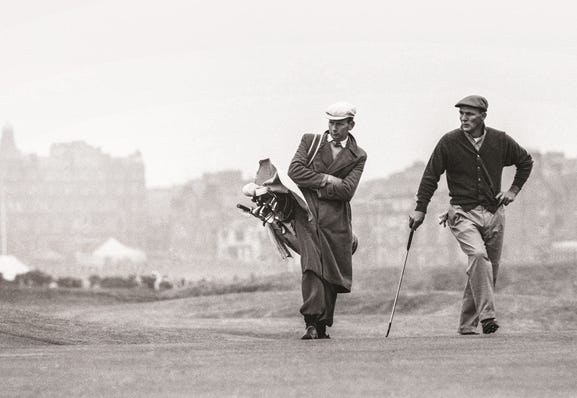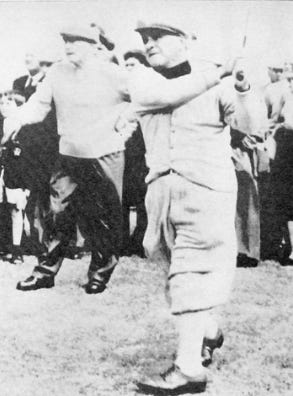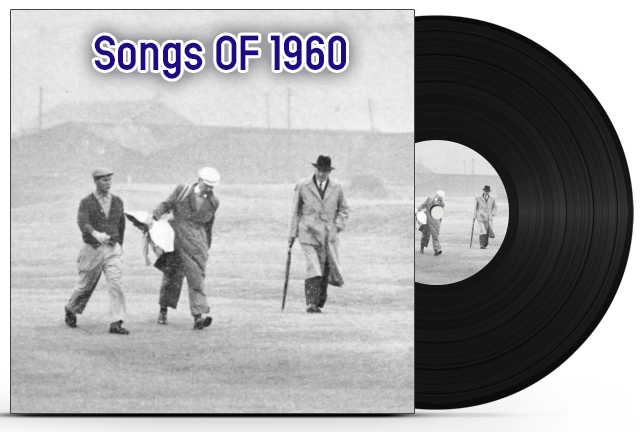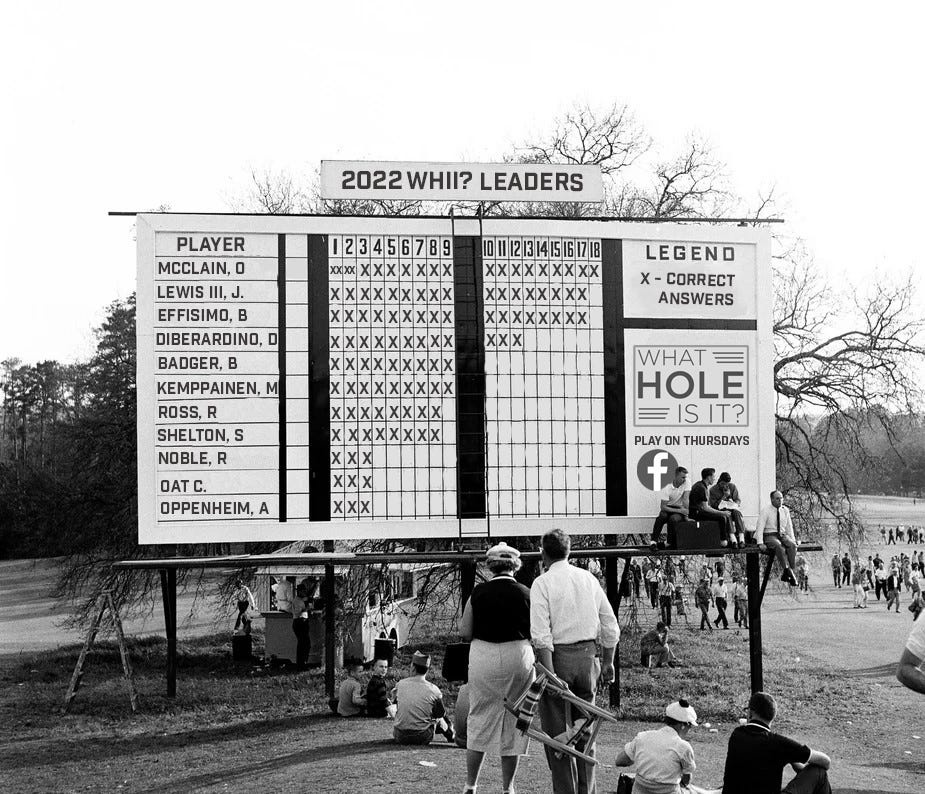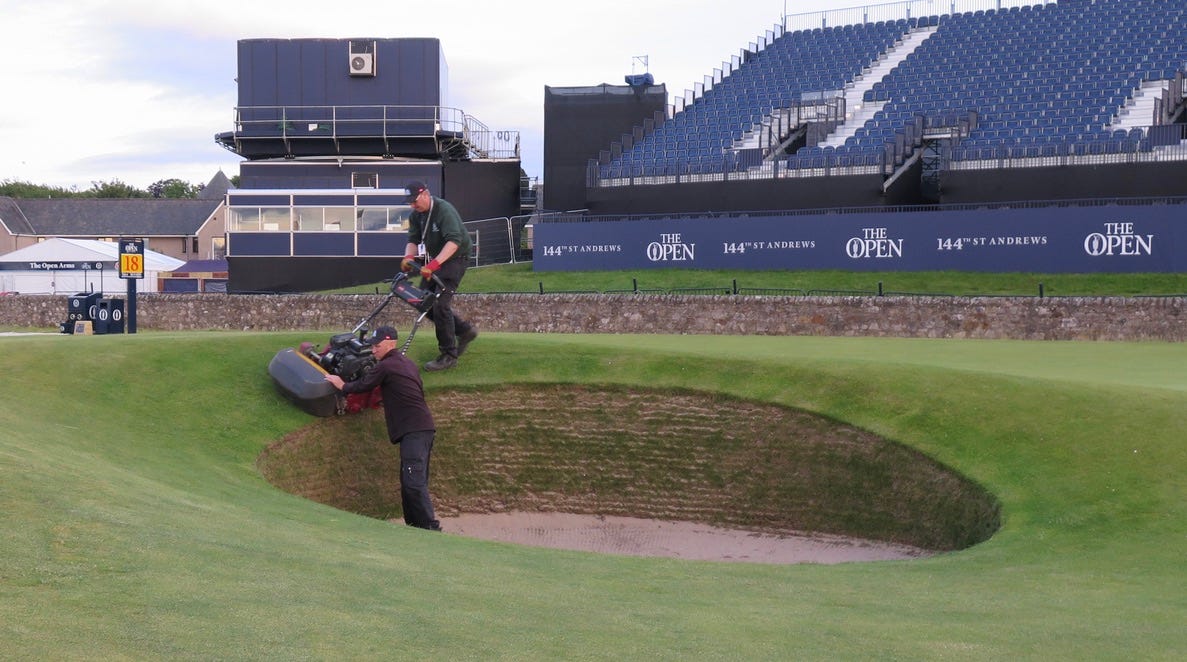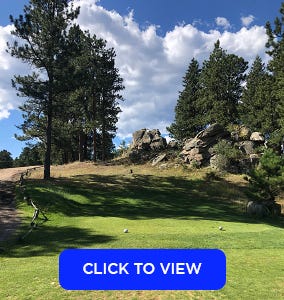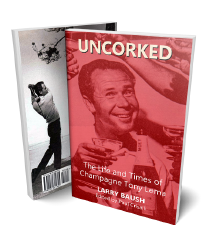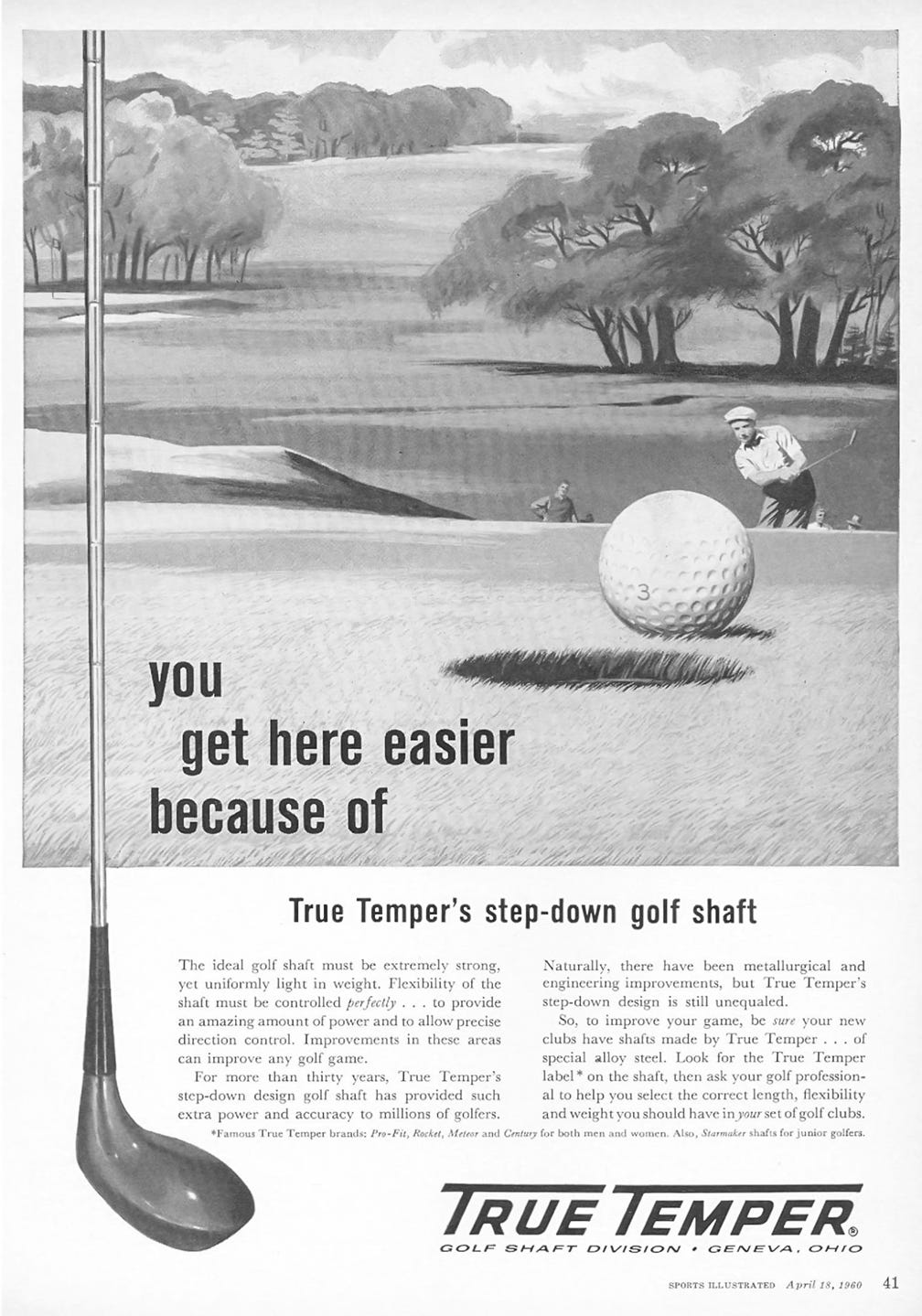The 1960 Open Championship and the Birth of the Modern Grand Slam
Arnold Palmer had the Masters and the U.S. Open under his belt in 1960. He headed off to the Old Course at St. Andrews with hopes of gaining the third leg to a modern grand slam
It’s a major week! Love waking up early to watch the action from across the pond. They are playing the 150th Open Championship at St. Andrews. We’re going to go back to the 100th playing of this prestigious tournament which was also played at the Old Course in St. Andrews. Arnold Palmer was attempting to win the third leg of the modern Grand Slam, a concept that he had come up with. Let’s backspin to see how he did.
We’ve packed the newsletter this week with Open Championship content. Check out the links as we’ve brought back the Check It Out feature. Scroll down to see and get ready for history to be made.
We love to get feedback! Let us know what you think about Tour Backspin and the stories we tell. Email me at larry@tourbackspin.com.
Listen to The Tour Backspin Show podcast HERE or on Spotify and Apple Podcast.
Congratulations to Gordy Graybeal, one of our many PGA Class A professional subscribers and the winner in this week’s WHAT HOLE IS IT? The featured hole was #16 at Firestone Golf Course in Akron, OH. Gordy beat out six other correct answers in the random drawing. Submit a “Guest Post” picture for WHAT HOLE IS IT? and if we use it, you’ll win a prize and also be credited with a correct score on the leader board. Send your pic to larry@tourbackspin.com. Scroll down for your chance to win in this week’s WHAT HOLE IS IT?
Our WHAT HOLE IS IT? is from the John Johnson archives of golf course photos from the 1980s and 1990s.
We’re playing Open Championship Trivia this week on the Tour Backspin Quiz. Scroll down to play.
Our vintage ad is going back to 1960, a time when advancements in equipment threatened the length of courses at the time (sound familiar?). We had this slated for last week’s email, but something went wrong so we’re using it this week. It’s a better fit this week, anyway. Scroll down to see.
Did you miss a previous newsletter? You can view it HERE. Forward this email to a friend. Was this newsletter forwarded to you? You can sign up HERE.
Okay, we're on the tee, let's get going.
Palmer Attempts to Add The Open Championship to His Major Wins of 1960
Arnold Palmer and his caddie at the Old Course in St. Andrews
It is Monday, June 20, 1960, and Arnold Palmer was en route to Portmarnock in Ireland where he was teaming up with Sam Snead in the Canada Cup matches. This was a competition, dreamed up by the impresario Fred Corcoran, that pitted two-man teams from different countries.
Palmer was also using the trip, and competition, to warm up for his attempt to qualify, and play in, The Open Championship at the Old Course in St. Andrews. On the previous Saturday, Palmer came from seven shots behind to win the U.S. Open at Cherry Hills in Denver, CO. In April, Palmer birdied the last two holes to win the Masters. He now admitted to Oscar Fraley of the UPI that he had Grand Slam aspirations.
“But now I’ve got Grand Slam ideas of my own,” Palmer told the famed golf reporter. “I’d like to add the British Open and the PGA Championship to those Masters and U.S. Open championships this year.”
Palmer had come up with the idea of the modern Grand Slam, one that would be an accomplishment as least as great as the Grand Slam attained by Bobby Jones in 1930. He was now in position to attempt to add the third leg, The Open Championship.
How did Palmer do in his first attempt at playing The Open Championship on the links of the Old Course at St. Andrews? Let’s backspin to find out.
It’s Sunday, June 26th, 1960, and Arnold Palmer and Sam Snead have just walked off with the Canada Cup title. They won this international team event by a whopping eight shots. Snead blew a three-stroke lead in the individual component of the event finishing second to Flory Van Donck of Belgium. Snead finished in second place while Palmer shot a final round 69 to finish in a tie for third place with Britain’s Harry Weetman.
400 golfers were entered into the qualifying for the 100th edition of The Open Championship. Two rounds, one over the Old Course at St. Andrews and one over the New Course would be played to whittle the field down to 100. The first round would be played on Monday, July 4th and the second round would be played the next day.
Palmer was joined by his father, known as “Pap” in St. Andrews on Monday. Pap watched as his son shot a first round 67 that all but assured that he would qualify for The Open, and his second round 75 qualified him easily. There were only four Americans who qualified; Palmer, Bill Johnson of Provo, UT, Jack Issacs, the civilian pro at the Langley Air Force Base course, and 58-year-old Gene Sarazen. 18 other American players failed to qualify. It took a score of 147 to qualify.
58-year-old Gene Sarazen at the 1960 Open Championship (photo: Sports Illustrated)
The first round of the 100th Open Championship began on Wednesday, July 6th, with the second round scheduled for the next day and the 36-hole final round scheduled for Friday. Palmer began his quest for the Grand Slam by shooting an opening round 70 in a strong wind that blew over the links at the Old Course. This put him three-strokes back of the leader, Roberto De Vicenzo of Argentina (although he was registered as playing out of Mexico).
“I’m going to gamble,” Palmer said before his round. “I gambled in the Masters and birdied the last two holes. I gambled again in the U.S. Open and picked up seven strokes on the last round to win. I’m not going to change those methods now.”
De Vicenzo shot another 67 in the second round and this put him seven shots in front of Palmer who shot a 71. Kel Nagle of Australia sat at 136, two strokes off De Vicenzo’s pace while his fellow countryman, Peter Thompson was at 141, tied with Palmer. Sebastian Miguel of Spain was also at 141.
Friday’s 36-hole final round began under cloudy skies with just a touch of wind and as the round progressed, the weather alternated between bright sunshine and rain. Palmer was ready to make one of his patented charges.
“I’m going to gamble,” Palmer said before his round. “I gambled in the Masters and birdied the last two holes. I gambled again in the U.S. Open and picked up seven strokes on the last round to win. I’m not going to change those methods now.”
“The game is on.”
He played perfectly for the first 16 holes, hitting powerful drives. He ran in birdies at the second and fifth holes and finished the first nine holes with a score of 34. Palmer then added another birdie at the 13th where he made one of the best putts of his week; a tricky 12-footer than had to move over two rolls in the green. It was an outstanding putt on a week where his putter was not on fire.
“The game is on,” Palmer told a friend as he came off the green, rolled up his sleeves and bounded for the 14th tee. He was fired up and he attempted to draw his drive but watched as the left-to-right wind nullified his efforts. His ball ended up barely inside the long stone wall that marked the out-of-bounds on the right side of the hole. Despite coming so close to disaster, he was able to recover and added another birdie. But he had trouble at the last two holes with three-putts on both resulting in bogeys. He finished with a 70 that put him four strokes behind Kel Nagle who was at 207. De Vicenzo fell to 209 after a disappointing 75.
Just as the leaders were finishing their morning rounds, a cloudburst hit the Old Course. The resulting deluge required the postponement of the afternoon final round. This marked only the second time a postponement of a round in The Open Championship was required in its 100 years of being held.
The players returned for the rare final 18 holes played on a Saturday and Palmer started quickly with birdies on the first and second holes. At the first hole he stuck his wedge approach to two feet from the cup and at the second his wedge shot approach finished 15-inches from the cup. After his missed a 10-foot birdie at the third, the fire seemed to go out of his game for a spell. He took three strokes to get down from the edge at the long fifth hole. He finished the front nine at 2-under par 34.
Nagle three-putted the 15th and the lead was now just two shots.
Kel Nagle was keeping up with Palmer, playing in the group just behind the American. He birdied the eighth and ninth holes, during the height of another Scottish rainstorm, and finished the first nine holes with a 34. Palmer was unable to make up any ground on the Australian. De Vicenzo was now out of it as the tournament had boiled down to a two-man affair.
Palmer made a birdie at the 13th hole where he drained a seven-foot putt. The lead was now down to three. Nagle three-putted the 15th and the lead was now just two shots. At the treacherous 17th hole, “The Road Hole”, Palmer overshot the green but hit a wonderful recovery shot. He used his putter and ran the ball up a sharp bank of clumpy rough and judged the shot perfectly as the ball finished within two feet of the hole. He tapped in his par putt and went to the 18th tee.
After a good drive at the final hole, Palmer fired his wedge to four feet from the hole and dropped the birdie putt. Nagle would have to finish with two fours to win, not an easy chore at the Old Course.
Nagle was studying a six-foot putt to save par at the 17th hole when the roar from Palmer’s birdie at the 18th hole erupted. Nagle knew exactly what the roar meant. With determination he stroked the par putt home. At the 18th, he slammed the door on Palmer’s grand slam expectations as he lofted a lovely wedge shot to a yard from the cup assuring his four. He nervously stroked his first putt missing by mere inches and then tapped in the winning putt.
Palmer had put up a great fight, but in the end, he came up one shot shy of securing the third leg of the modern Grand Slam.
Kel Nagle (photo: Sports Illustrated)
The British press was not happy with Sam Snead. Read our Bonus Story to find out why.
Check It Out is back packed full of Open Championship links. So, check it out below.
It’s a new playlist from 1960. Listen HERE.
Please help us grow by forwarding this email to a friend who would enjoy it. Thanks.
Enjoy!
Larry Baush
Follow us on Facebook, Instagram, Twitter and YouTube
Thanks for reading! Please let your family, friends and colleagues know they
can sign up for email delivery of this free newsletter through this link.
WHAT HOLE IS IT?
Are you on the leader board?
Tour Backspin Quiz | The Open Championship Trivia
What year was The Open Championship first broadcast on television in the United States? What show aired the tournament?
Answer below
Bonus Story
Sam Snead made the trip to Portmarnock, Ireland, to team up with Arnold Palmer for the Canada Cup. They won the team portion of the event and then Palmer headed to St. Andrews to play in The Open Championship while Snead headed home to play in the Buick Open on the PGA Tour. This did not go over well with the Scots at the Old Course.
Snead won The Open Championship in 1946 at St. Andrews and the locals thought that it would only be fitting for him to play in the centennial of the tournament. The press was merciless in their scorn of Snead as they labeled him a “golfing ingrate” who failed to give back to the game that had given him so much. They also believed that Snead was chasing the money available at the Buick, one of the better paying purses on the tour schedule. The purse for the Buick was $52,000 while the purse for The Open Championship was £7,000 ($19,600).
The pros, though, came to Slammin’ Sammy’s defense. To a man they all agreed that “it seems to be Sam’s business and nobody else’s”.
Veteran Henry Cotton said, “One fellow wrote an absolute scurrilous story.” Cotton had just come off the 18th green and was changing his shoes at the trunk of his Cadillac. “I think the story is actionable in the British courts under our libel laws and I’m going to send it to Sam for action if he wants to do anything about it. I’m for Sam.”
Gene Sarazen, who at 58-years-old qualified for the 100th Open, said, “The British feel hurt, but what about Bobby Locke? He’s in London, he won it four times, and he didn’t bother coming up. Why don’t they make some noise about him?”
Snead won $1,550 at the Buick Open.
Tiger Woods talks LIV Golf, Greg Norman and the players who’ve left the PGA TOUR to play on the upstart tour. Read it HERE.
Highlights of the 1960 Open Championship. Watch HERE (you won’t believe the rain) and HERE.
Watch Collin Morikowa relinquish the Claret Jug upon his arrival at St. Andrews. Watch it HERE.
Lee Trevino’s thoughts on the 150th Open Championship. Read it HERE.
Watch The Road To The Open series as Peter Finch, James Robinson, Chris Lewis and Sam Forgon on their journeys to qualify for The Open. Watch the trailer:
Read about how Tony Lema captured the 1964 Open Championship at St. Andrews. Read it HERE.
Follow Geoff Shackelford’s Quadrilateral on Substack for on-the-grounds coverage of the 150th Open Championship. Follow HERE. He’s got some great photos, as well. Like this one on pot bunker grooming:
(photo: Geoff Shackelford)
Read about every hole at the Old Course HERE. Or watch a flyover HERE.
Tiger and Justin Thomas on the Old Course. Watch HERE.
Blind Shot
Click for something fun. 👀
Tour Backspin Quiz Answer:
The Open Championship was first broadcast on television in the U.S. in 1961. It was broadcast a week later on the new show ABC Wide World of Sports.
I'd love to hear your feedback! Email me at larry@tourbackspin.com.






